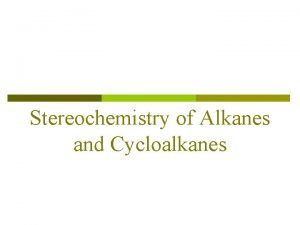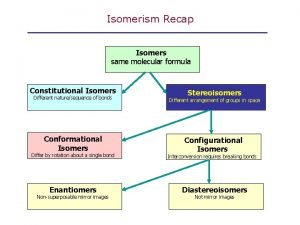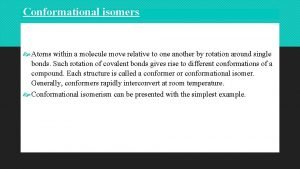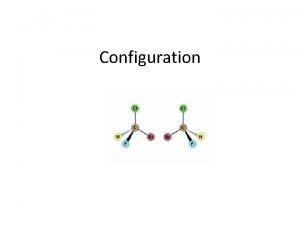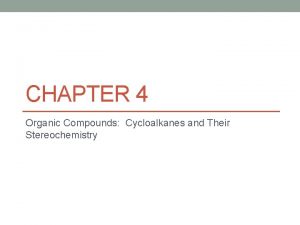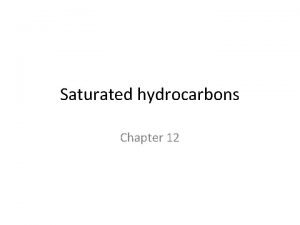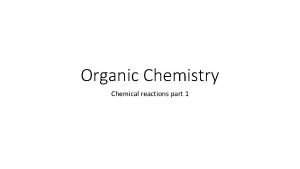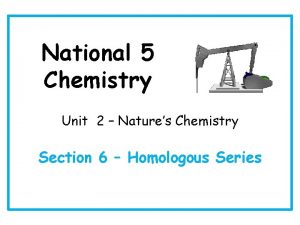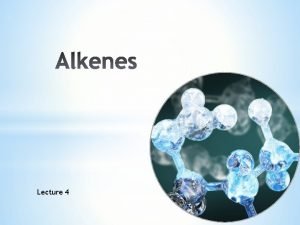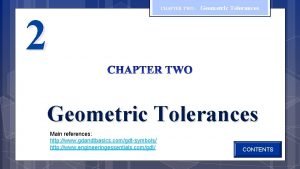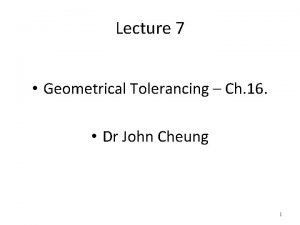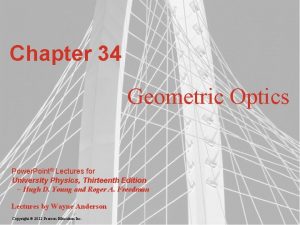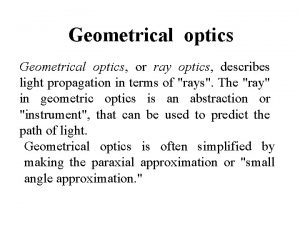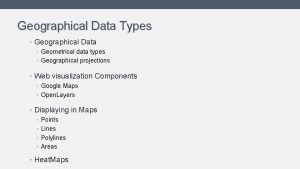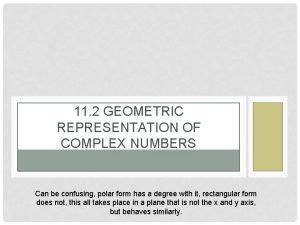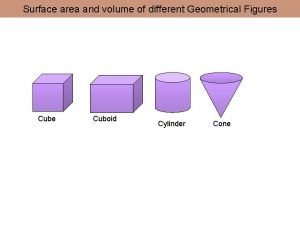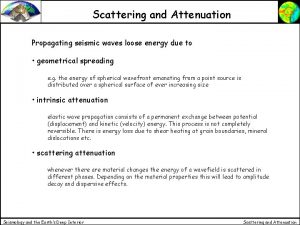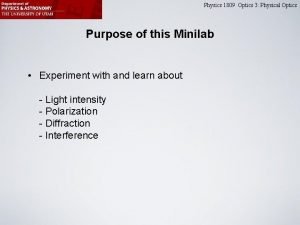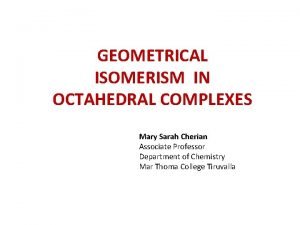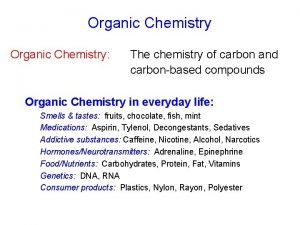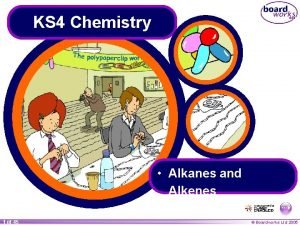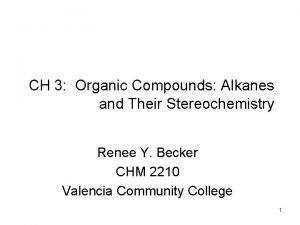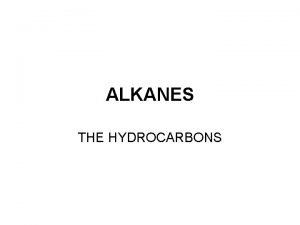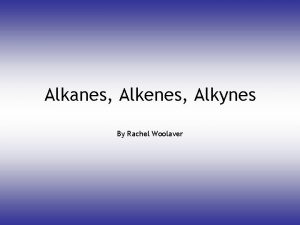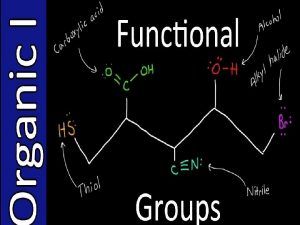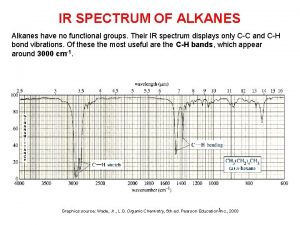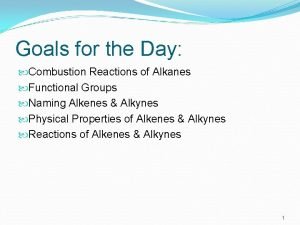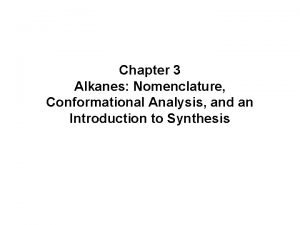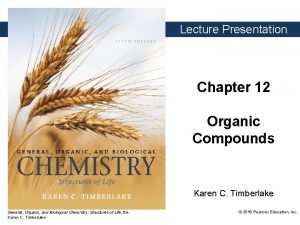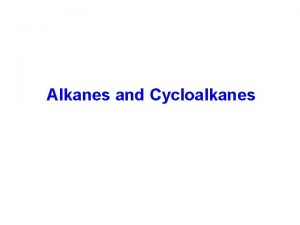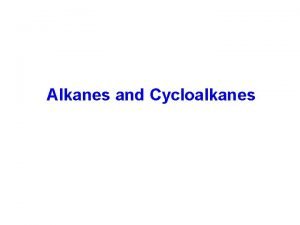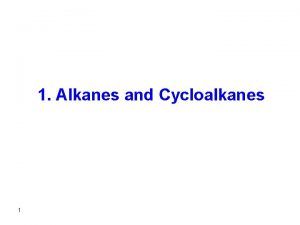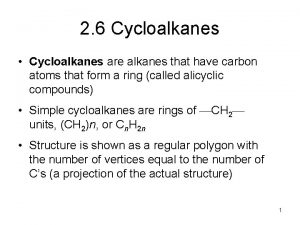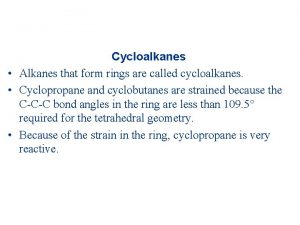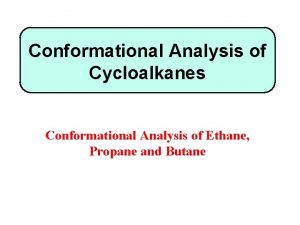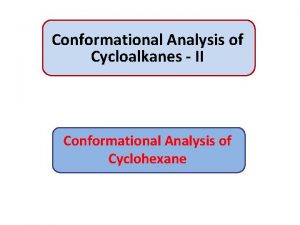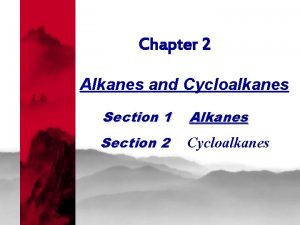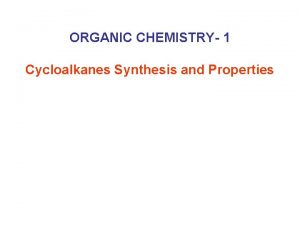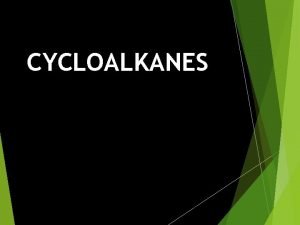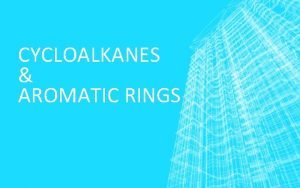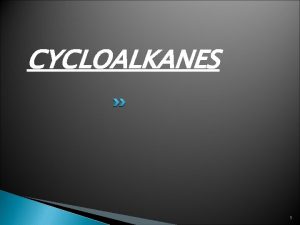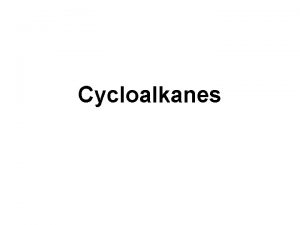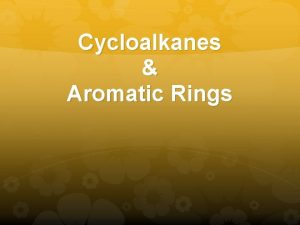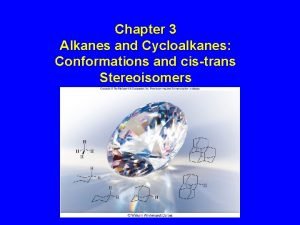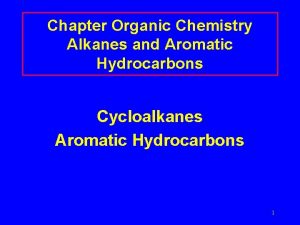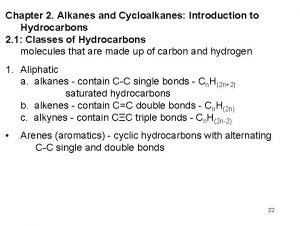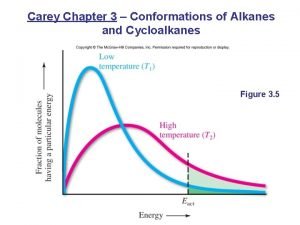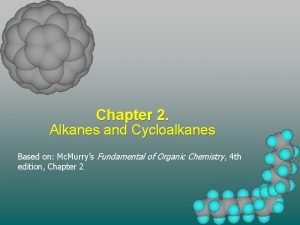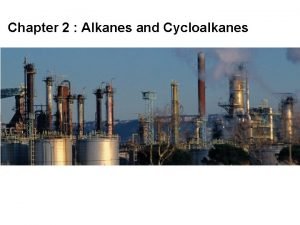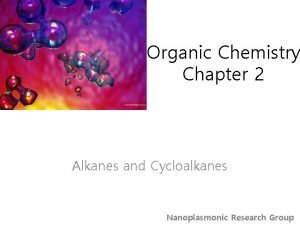Chapter 2 Alkanes and Cycloalkanes Conformational and Geometrical














































- Slides: 46

Chapter 2 Alkanes and Cycloalkanes; Conformational and Geometrical Isomerism

• Hydrocarbons are compounds that contain only carbon and hydrogen. There are three main classes of hydrocarbons, based on the types of carbon–carbon bonds present. 1 -Saturated hydrocarbons contain only carbon–carbon single bonds. 2 -Unsaturated hydrocarbons contain carbon–carbon multiple bonds, double bonds, triple bonds, or both. 3 -Aromatic hydrocarbons are a special class of cyclic compounds related in structure to benzene. • Saturated hydrocarbons are known as alkanes if they are acyclic, or as • cycloalkanes if they are cyclic.

2. 1 The Structure of Alkanes • Alkanes are hydrocarbons containing only single saturated bonds. General formula: Cn. H 2 n+2. • The simplest alkane is methane. • Its tetrahedral three-dimensional structure. • Alkanes with carbon chains that are unbranched are called normal alkanes or n-alkanes. • Each member of this series differs from the next higher and the next lower member by a -CH 2 -group (called a methylene group). • A series of compounds in which the members are built up in a regular, repetitive way like this is called a homologous series.


• Compounds of a homologous series differ by a regular unit of structure and share similar properties. • PROBLEM 2. 2 Which of the following are alkanes? a. C 7 H 16 b. C 7 H 12 c. C 8 H 16 d. C 29 H 60

2. 2 Nomenclature of organic compounds • In the early days of organic chemistry, each new compound was given a name that was usually based on its source or use. Examples include limonene (from lemons), α-pinene (from pine trees), coumarin (from the tonka bean, known to South American natives as cumaru) • Internationally recognized systems of nomenclature were devised by a commission of the International Union of Pure and Applied Chemistry; they are known as the IUPAC

2. 3 IUPAC rules for naming alkanes 1. The general name for acyclic saturated hydrocarbons is alkanes. The -ane ending is used for all saturated hydrocarbons. This is important to remember because later other endings will be used for other functional groups. 2. Alkanes without branches are named according to the number of carbon atoms. These names, up to ten carbons, are given in the first column of Table 2. 1. 3. For alkanes with branches, the root name is that of the longest continuous chain of carbon atoms. For example, in the structure

the longest continuous chain (in color) has five carbon atoms. The compound is therefore named as a substituted pentane, even though there are seven carbon atoms altogether. 4. Groups attached to the main chain are called substituents. Saturated substituents that contain only carbon and hydrogen are called alkyl groups. An alkyl group is named by taking the name of the alkane with the same number of carbon atoms and changing the -ane ending to -yl.

5. The main chain is numbered in such a way that the first substituent encountered along the chain receives the lowest possible number. Each substituent is then located by its name and by the number of the carbon atom to which it is attached. • When two or more identical groups are attached to the main chain, prefixes such as di-, tri-, and tetra- are used. Every substituent must be named and numbered, even if two identical substituents are attached to the same carbon of the main chain. 2, 3 -dimethylpentane

6. If two or more different types of substituents are present, they are listed alphabetically, except that prefixes such as di- and triare not considered when alphabetizing. 7. Punctuation is important when writing IUPAC names for hydrocarbons are written as one word. Numbers are separated from each other by commas and are separated from letters by hyphens. There is no space between the last named substituent and the name of the parent alkane that follows it.

notes 1. Locate the longest continuous carbon chain. This gives the name of the parent hydrocarbon. For example, 2. Number the longest chain beginning at the end nearest the first branch point. For example,

3. Write the name as one word, placing substituents in alphabetic order and using proper punctuation. Example 2. 2 2, 2 -dimethylpentane

2. 4 Alkyl and Halogen Substituents

R is the general symbol for an alkyl group. Halogen substituents are named by changing the -ine ending of the element to -o. Ffluoro- Clchloro- Brbromo- Iiodo- Give the common and IUPAC names for CH 3 CH 2 Br.

2. 5 Use of the IUPAC Rules

• PROBLEM 2. 8 Explain why 1, 3 -difluorobutane is a correct IUPAC name, but 1, 3 -dimethylpentane is not a correct IUPAC name.

2. 7 Physical properties and Intermolecular Interactions • Alkanes are insoluble in water. That is because water molecules are polar, whereas alkanes are nopolar. (all C-C and C-H bonds are nearly purely covalent. ) • Alkanes have lower boiling points for a given molecular weight than most other organic compounds. The electrons in a nonpolar molecule can become unevenly distributed within the molecule, causing the molecule to have partially positive and partially negative end. The temporarily polarized molecules causes its neighbor molecules polarized as well. Such interaction are called Van der Waals attraction.

• The boiling points for alkanes rise as the chain length increases and fall as the chains become branched and more nearly spherical in shape.


2. 8 Conformations of Alkanes • A simple molecule has an infinite number of shapes as a consequence of rotating one single bond. These arrangements are called conformations or conformers. Conformers are stereoisomers, isomers in which the atoms are connected in the same order but are arranged differently in space.

• Two possible conformers for ethane are staggered and eclipsed.


Staggered more stable than eclipsed rotamers

https: //youtu. be/o. G 1 a. CQvkk. D 0


Example 2. 4 Draw the Newman projections for the staggered and eclipsed conformations of propane.

2. 9 Cycloalkanes Nomenclature and Conformation • Cycloalkanes are saturated hydrocarbons that have at least one ring of carbon atoms. • Cycloalkanes are named by placing the prefix cyclo- before the alkane name that corresponds to the number of carbon atoms in the ring.

• Nomenclature • Alkyl or halogen substituents attached to the rings are named in the usual way. • If only one substituent is present, no number is needed to locate it. • If there are several substituents , numbers are required. One substituent is always located at ring carbon number 1, and the remaining ring carbons are then numbered consecutively in a way that gives the other substituents the lowest possible numbers


What are the conformations of cycloalkanes? • Cyclopropane, with only three carbon atoms, is necessarily planar. The C-C-C angle is only 60° (the carbons form an equilateral triangle), much less than the usual sp 3 tetrahedral angle of 109. 5°. The hydrogens lie above and below the carbon plane, and hydrogens on adjacent carbons are eclipsed.

• Cycloalkanes with more than three carbon atoms are nonplanar and have “puckered” conformations. In cyclobutane and cyclopentane, puckering allows the molecule to adopt the most stable conformation (with the least strain energy). Puckering introduces strain by making the C-C-C angles a little smaller than they would be if the molecules were planar; however, less eclipsing of the adjacent hydrogens compensates for this.

• Six-membered rings are more common and stable. If cyclohexane were planar, the internal C-C-C angles would be those of a regular hexagon, 120°—quite a bit larger than the normal tetrahedral angle (109. 5°). The resulting strain prevents cyclohexane from being planar (flat). Its most favored conformation is the chair conformation, an arrangement in which all of the C-C-C angles are 109. 5° and all of the hydrogens on adjacent carbon atoms are perfectly staggered. • In the chair conformation of cyclohexane, the six axial hydrogen atoms lie above and below the mean plane of the ring, while the six equatorial hydrogens lie in the plane.


Another puckered conformation for cyclohexane, one in which all C-C-C angles are the normal 109. 5°, is the boat conformation.

2. 10 Cis-Trans Isomerism in Cycloalkanes • Stereoisomerism deals with molecules that have the same order of attachment of the atoms, but different arrangements of the atoms in space. Cis–trans isomerism (sometimes called geometrical isomerism) is one kind of stereoisomerism, and it is most easily understood with a specific case.

• Cis: like groups on same side of ring • Trans: like groups on opposite sides of ring

2. 11 Summery of Isomerism

PROBLEM 2. 17 Classify each of the following isomer pairs according to the scheme • a. cis- and trans-1, 2 -dimethylcyclohexane • b. chair and boat forms of cyclohexane • c. 1 -fluoropropane and 2 -fluoropropane

2. 12 Reactions of Alkanes • All of the bonds in alkanes are single, covalent, and nonpolar. Hence alkanes are relatively inert. • Because of this inertness, alkanes can be used as solventsfor extraction or crystallization as well as for carrying out chemical reactions of other substances.

1) Oxidation and Combustion: alkanes as fuels Partial oxidation of hydrocarbon

2. 12 b Halogenation of alkanes. • General formula For methane • The reaction is called chlorination. This process is a substitution reaction, as a chlorine is substituted for a hydrogen. An analogous reaction, called bromination, occurs when the halogen source is bromine.

• If excess halogen is present, the reaction can continue further to give polyhalogenated products. Thus, methane and excess chlorine can give products with two, three, or four chlorines

2. 13 Free Radical Chain Mechanism of Halogenation • A reaction mechanism is a step-by-step description of the bond-breaking and bond-making processes that occur when reagents react to form products. In the case of halogenation, various experiments show that this reaction occurs in several steps , and not in one magical step. Indeed, halogenation occurs via a free-radical chain of reactions. • The chain-initiating step is the breaking of the halogen molecule into two halogen atoms.



• Homework 1 26 28 31 35 41 44 45 47 48 50
 Gauche conformation
Gauche conformation Diastereomers vs enantiomers
Diastereomers vs enantiomers Conformational isomers
Conformational isomers Non superimposable mirror images are
Non superimposable mirror images are Cycloalkanes and their stereochemistry
Cycloalkanes and their stereochemistry Unsaturated hydrocarbon
Unsaturated hydrocarbon Cycloalkanes
Cycloalkanes Bromine water test
Bromine water test Alkane chemical formula
Alkane chemical formula Basic geometric features of symbology
Basic geometric features of symbology Difference between structural and geometric isomers
Difference between structural and geometric isomers Geometrical tolerance
Geometrical tolerance Geometrical tolerances
Geometrical tolerances Geometric optics ppt
Geometric optics ppt Geometrical
Geometrical Geometrical
Geometrical Geographical data types
Geographical data types Geometric representation of complex numbers
Geometric representation of complex numbers Curved surface of cylinder
Curved surface of cylinder Geometrical spreading
Geometrical spreading Geometrical shadow
Geometrical shadow Geometrical isomerism
Geometrical isomerism Alkanes solubility
Alkanes solubility Saturated bond
Saturated bond Uses of alkanes
Uses of alkanes Alkanes list
Alkanes list General formula for alkyl group
General formula for alkyl group Alkanes alkenes alkynes
Alkanes alkenes alkynes Alkanes list
Alkanes list Ir spectra of alkanes
Ir spectra of alkanes Combustion of alkynes
Combustion of alkynes Alkane complete combustion
Alkane complete combustion Covalently def
Covalently def Alkylation of alkanes
Alkylation of alkanes Alkane viscosity
Alkane viscosity Relative stability of isomeric alkanes
Relative stability of isomeric alkanes Iupac stands for
Iupac stands for Test for alkenes
Test for alkenes Priority order of functional group ncert
Priority order of functional group ncert Meth eth
Meth eth Applications of alkanes
Applications of alkanes Chapter 7 ionic and metallic bonding chapter answer key
Chapter 7 ionic and metallic bonding chapter answer key Chapter 7 ionic and metallic bonding answer key
Chapter 7 ionic and metallic bonding answer key Ionic compound properties
Ionic compound properties Chemistry chapter 7 ionic and metallic bonding
Chemistry chapter 7 ionic and metallic bonding 9 chemical names and formulas
9 chemical names and formulas The red tent book summary
The red tent book summary
